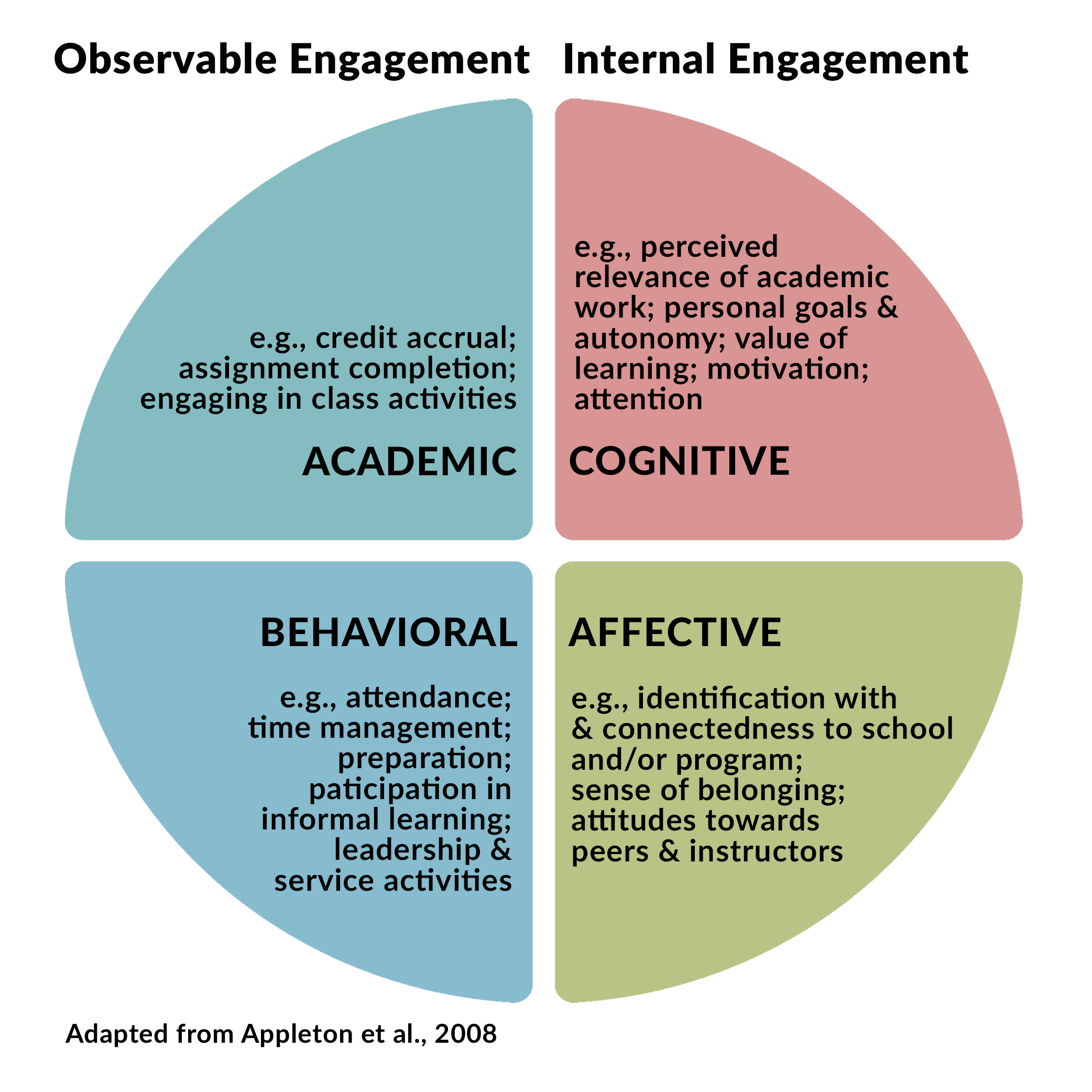
Engagement is a key component of a meaningful learning experience. Instructors who prioritize engagement will facilitate opportunities for learners to achieve course learning objectives. Some types of engagement are directly observable, while others are internal and not directly observable. However, all subtypes of engagement are interrelated components of the learning experience. There are at least four types of engagement to consider cultivating within your learning environment:
- Academic engagement: observable, formally assessed knowledge-related interactions
- Behavioral engagement: observable actions of effort surrounding involvement in learning
- Cognitive engagement: metacognitive and self-regulatory strategies learners employ to increase understanding of course content
- Affective engagement: how students feel within and about their learning environment

There are several different methods and strategies for learner engagement. While not exhaustive, consider the strategies below to engage your learners academically, behaviorally, cognitively, and affectively.
Promoting Student Engagement through Active Learning
Active learning strategies experientially invite learners into engaging with course material. Methods include, but are not limited to, discussions, case studies, and impromptu writing activities. Active learning strategies are most useful when employed alongside clear expectations and evaluation strategies that are accompanied by timely, constructive feedback.
Learn more about Active Learning
Flipping the Classroom
Flipped classrooms are a method of active learning. In flipped classrooms, learners receive information prior to class, and class time is primarily devoted to activities designed to stimulate higher-order thinking skills.
Learn more about Flipped Classrooms
Facilitating Dynamic Discussions
Class discussions allow learners an opportunity to process and exchange information they have received. Understanding your role as a facilitator is an important component to the execution of meaningful class discussions.
Learn more about Facilitating Class Discussions
Recognizing Critique as a Method of Engagement
As students transition from their undergraduate education into graduate studies, they are also making important developmental transitions regarding how they build, apply, question, and embody concepts relevant to public health practice, both in the classroom and through their lived personal and professional experiences. In this transition, the learning environment of students has vastly expanded from a stage of dependency to a more self-directed method of inquiry, which often involves critique. It is important to consider that criticism can be a meaningful method of engagement for adult learners as they seek to more deeply understand and apply course content.
Learn more about Critical Engagement and how to prepare to Address it in the Classroom.
Teaching with Technology
Technology can be leveraged within the classroom to offer learners additional opportunities to engage with course content. Consider ways to align selected technology tools with learning objectives.
Learn more about Teaching with Technology
Large Lecture Instruction
Maintaining learner engagement can be challenging in large classes. While challenging, large courses should not be solely limited to lecture-based instruction. Small group work is one effective method for facilitating engagement in large courses.
Learn more about Small Group Work
Office Hours
Office hours offer learners an opportunity to ask questions, cultivate curiosity, clarify confusion, and express specified interests in course content and requisite professional opportunities. As an instructor, remember to encourage your learners to attend and leverage office hours as an asset to their learning.
Learn more about Office Hours
Community-Engaged Learning
Community-engaged projects offer learners an opportunity to experience fieldwork while simultaneously supporting course learning objectives.
Learn more about Service Learning

